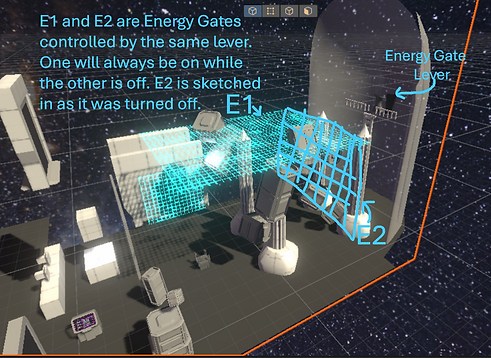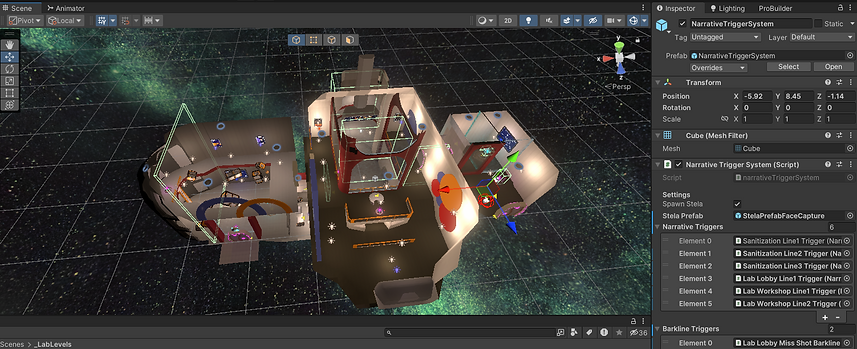top of page
Level 1 Finalized

Level 1 Process
Lab Level 1, the first level of the game, initially started out as two rooms. The idea was that the first room would be a puzzle with energy gates and multiple levers corresponding with each gate, controlling the charge state. The player would learn about energy gates in the first half, how an uncharged ball interacts with them, and how they can be active in a puzzle, separate from the ball, in order to line the elements up before taking their shot. The player would then go into the second room with an already-charged ball and it would be more of an open play space. The room would have obstacles and a clear line of sight on where they need to bring the ball to restore power to the room, but how they get there would be up to what kind of shot they want to go for.
Ultimately, this level went through multiple rounds of changes as our game mechanics changed, as we figured out what room we'd have in the team to create certain assets or puzzle elements, and mainly we decided that every single room, even if it is one continuous level, should always start with a new, uncharged, energy core.
After going through playtests, it became clear that the first level needed to be more introductory than it was originally. Energy gates are the first new puzzle elements that the player encounters after the tutorial, so this led to me creating a much smaller "Sanitization" room the player encounters first in Lab Level 1. This room is much smaller, and much more directed(with the use of our pilot companion character, S.T.E.L.A.), in showing players exactly how energy gates work.
This also allowed the second room to be expanded upon, needing to create space for the new room to enter from, and to have it feel less directed and formed specifically for the level. Instead, the larger space allows it to feel more like a lobby of the lab and a real, lived in space.
The last major change in this version was expanding the third room a bit, making a separate space, behind glass, at the front of the room. The room behind glass at the front was at first accessed through the hallway the player comes into, so the player could go in there and see the entire chamber at the start, as well as it serving as a space for lore and exploration. I also rearranged the puzzle elements in this final room, adding an energy core spawner and putting it front and center in the room, due to the gameplay changes I mentioned at the end of the last section.
Final Misc. Changes, Set Dressing & Lighting


Until the level was completely finalized and I went on to lighting, there was a constant push and pull from playtesting results and our own interior conversations that led to minor changes continuing on the level. Some of it is pictured above, other parts I will touch on here, starting off with the final room in the level, the Lab Workshop. Some of the permanent changes made in the level were moving the energy core spawner to the top of the catwalk and putting a charge station at the bottom where the old spawner was—as we moved to every room in each level always starting with an uncharged core, this room needed a charging station. I also liked having the energy spawner at the top because once the model was in, and lighting was baked, it stood out in the room being at the top center of the end wall. Then, once you were there, overlooking the rest of the room gave great sightlines and added to the feeling of this being a play space—being at the top of the room, overlooking many different possibilities on how to get the ball down to the charging station. I also experimented with having interchangeable energy gates, controlled by a lever at the top by the ball spawner. The idea was one would serve as a barrier, while the other opened up a path for the player to shoot the energy ball into. I wanted the players to have a choice with their pathing, but also allow some more skill expression by hitting the ball and then flipping the lever to keep the ball trapped inside certain areas and not bounce to where the player didn't intend. It was ultimately scrapped as it wasn't being used as intended in playtests, but this experimentation led to the obstacle placement of crates in the final version of the level that ultimately led to the same outcome—multiple paths for the ball to go, with the player having a choice on higher difficulty shots but better chance at a "hole in one," or taking it a slow, safer way.
Along with these changes, the back room behind glass, the lore room, was no longer accessible through the doorway in the hall—that was now sealed shut. Instead, I broke a hole in the glass and added a crate there, then put a lever inside the room that controlled the energy gate blocking off the exit door and the energy core receiver. Not only would this force the players to go into this room and find lore posters and other props, but so too did the myself and the team like the feeling of encouraging exploring the space, finding the lever, and going through the broken glass. The other minor changes mainly took place in the second room, the large open "lobby," space, which is not pictured above. These included only having one energy gate at the front of the room, where the ball spawner was, so players didn't get confused and there was less space for the ball to wander in the large room. I also added a moving large screen controlled by the lever in the room, adding more spectacle and also objects to bounce the energy core off of.






Pictured above, from left to right, first is the level in its entirety before lighting and set dressing. Also seen in the picture is the setup of the dialogue and animation triggers for our companion character, S.T.E.L.A., which you can see in much more detail in my Narrative Design post for Starshot. Afterwards are in-process pictures of baked lighting for the first room, then going into the second room, the Lab Lobby, overlooking the ground level, and finally three images of the final room, the Lab Workshop. These were all in-process lighting bakes, they initially came out a bit too dark compared to the final bakes, but the overall atmosphere is what we intended for our chambers while they were in low power mode. We used pink lights, the color of S.T.E.L.A., to lead the player to the puzzle elements that would help get the power back on. The green lighting was the color representing that something else had taken over the ship, so lighting that wasn't intended to lead the player was this neon green which would then turn into a warm yellow/cream color when the power was returned to the spaces.
bottom of page
















